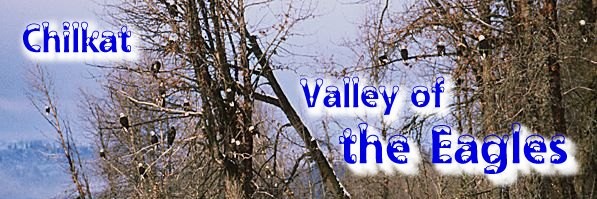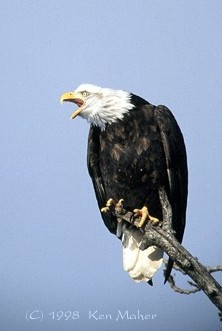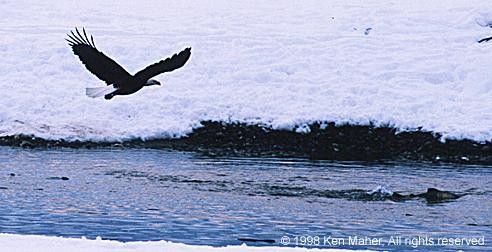
By Ken Maher
|
In November 1998, I made my third
November visit to the Chilkat Bald Eagle Preserve near Haines, Alaska. The preserve was
established to protect and perpetuate the world’s largest concentration of Bald
Eagles and their critical habitat. The banner photo gives you some idea why the locals
refer to the area as "The Valley of the Eagles." In November, as other rivers in
the area begin to freeze, warmer water begins to percolate up from the accumulation of
gravel, rock, sand and glacial debris over which the river flows. That water, which is 10
to 20 degrees warmer than above the surrounding temperatures, keeps the Chilkat River from
freezing, especially over about a five-mile stretch through the Preserve. Eagles congregate many coming from great distances to feast on the Salmon
that are still running up river and spawning as other rivers are freezing. Over 3,000
eagles have been counted in the Preserve during the peak period in mid- to late November.
It creates a wonderful problem for the nature photographer – which of the many eagles
to photograph and in what situations. This feature is about some of the decisions that I
made. |
|
|

|
|
Of course, one classic eagle image
is the portrait of the eagle perched against a blue sky. This image is a slight variation
of the classic image in that the eagle is not posed still and quiet, but is screaming
through a wide-open beak. It reminds me of the fantastic sounds of this Preserve. |
|
|
During
much of November in this area, the sky just will not cooperate. It is predominantly a very
boring and distracting light gray. Such skies will ruin your images and must be avoided.
In those situations, I look for eagles in perches with forest or distant hills behind
them. |

|
|
|
 |
Immature bald eagles do not have
the classic white heads and tail feathers, but their mottled appearance creates a
different looking portrait. Bald eagles require 4-5 years, of their normal 30 year plus
life span, to reach complete adult plumage. |
|
|
After spending some time in the
area, you can learn some favorite perches and be prepared to capture a landing eagle to
show the 6-7 foot wingspan. A little blur of the wings provides the feeling of motion just
before this eagle reaches the perch. |

|
|
|
 |
|
Watching the far side of the nearby
branch of the river provides good opportunities to photograph the eagles as they feed on
the salmon. With a little luck, you can even find some reflection opportunities like this
one. |
|
|
Even though the salmon are
plentiful, eagles often prefer to steal from one another than to pull their own salmon
out. This creates what is referred to as displacement. Displacement occurs when one eagle
flies at an eagle perched on a streamside salmon and scares or knocks it off to steal a
meal. It is difficult but fun to try to anticipate and capture that action. Here, I missed
my guess as to which direction the immature eagle would depart in when displaced by the
mature eagle, but I kind of like the shot anyway. |

|
|
|
 |
In attempts to avoid being
displaced, eagles will sometimes take their salmon to perches to feed on them. Sometimes
you can get a fairly close shot of a perched eagle with a salmon. In this case, the sky
was a light gray distraction, so I cropped it out. |
|
|

Photographing eagles in flight is a real challenge.
Here, however, there were opportunities to pan with eagles, as they would glide over the
water toward a streamside landing. With a little luck, you can even get a salmon in the
same shot.
|
|
|
These are but a few examples of the
fabulous photographic opportunities in the Valley of Eagles in November. There are other
places where eagles also gather in the winter which also create great photographic
opportunities. |

|
|
|
In any of these situations,
however, please respect the eagles and do not intentionally approach them so closely as to
make them fly from their perches. It is necessary for these large birds to conserve as
much energy as possible to survive the winter. Causing them to go into unnecessary flight
simply wastes some of that vitally important energy. Only the banner and the last two
photos in this feature were taken with a lens shorter than 600mm and in most cases, a 1.4x
teleconverter was also used to achieve the apparent closeness. --Ken Maher |
|
Email Ken Maher
____________________________________________________________
In case you missed
Nov. Feature..Garden of the Gods sequel...
Click Here
Oct. Feature..Garden of the Gods in fall
... Click Here
Sept. Feature..Aspen trip with
Greyhawk... Click Here
Aug. Feature..Jeri Childs in Bryce Canyon...Click Here
July Feature..Chris Varner moonlite
image...Click Here
_____________________________________________________________
|
The images on this site are
presented for your personal pleasure. All images appearing on these pages have a copyright
with all rights reserved. Many are water marked and/or coded. Re-posting and/or
reproduction in any manner, without the express "written" consent of the owner,
is strictly prohibited by law. |
|
____________________________________________________________
Current Feature
Main Gallery Contents Home
Email
All pages, graphics, created and maintained by
Greyhawk1
_____________________________________________________________________________________
This page hosted by GEOCITIES Get your own Free Homepage